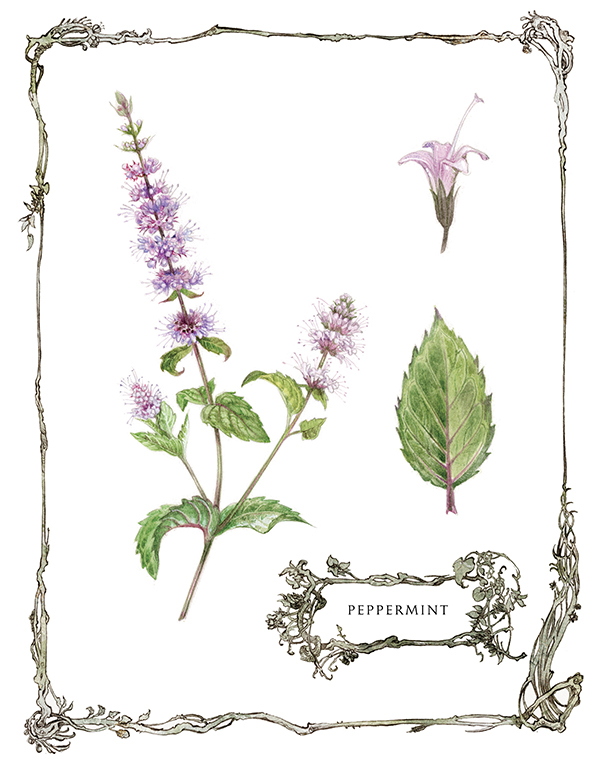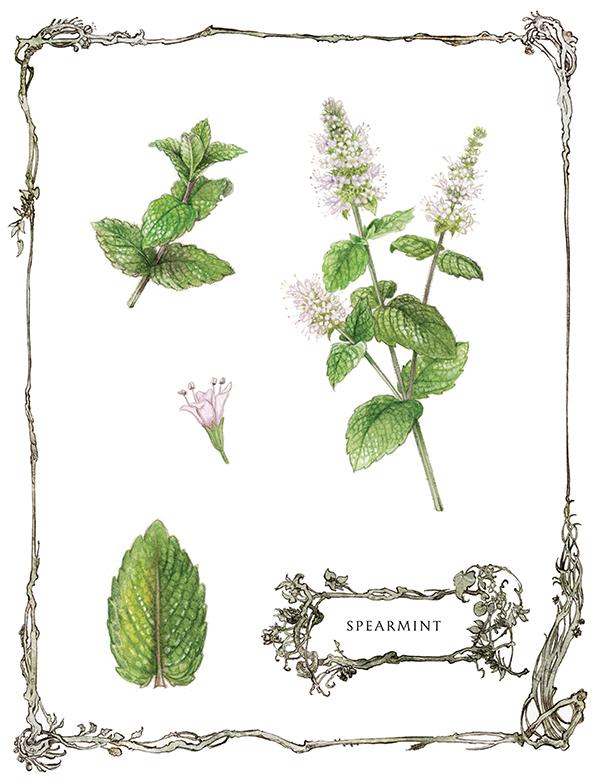Peppermint (Mentha x piperita)
Also known as: Balm Mint, Brandy Mint
Spearmint (Mentha spicata L., syn. M. viridis)
Also known as: Green Mint, Lamb Mint, Our Lady’s Mint, Sage of Bethlehem


Peppermint is a naturally-occurring hybrid between spearmint and water mint (Mentha aquatica). Its species name comes from the Latin piper, “pepper,” because the taste of this herb has a hint of pepper. While spearmint is considered the oldest species of mint, peppermint has been around for quite a long time, too. Dried peppermint leaves have been found in Egyptian burials dating to 1000 BCE.
The Greeks and Romans valued both mints for help with digestive issues. Spearmint leaves were sprinkled in bath water for restorative soaks by the Greeks. Both mints were introduced into England by the Romans. By the eighteenth century, peppermint and spearmint were widely used for medicinal and culinary purposes throughout Europe and North America.
Spearmint is the most commonly grown culinary mint. It is milder and less pungent than peppermint. Spearmint is sweet, whereas peppermint has a sharp flavor. In addition, it is second only to peppermint as a healing mint. Peppermint is so effective for many applications because it contains menthol; spearmint does not.
Medicinal Uses
Peppermint: Acne, asthma, bad breath, belching, bronchitis, burns, chest congestion, chilblains, colds, cough, dermatitis, diarrhea, digestive system support, expectorant, flatulence, flu, gallstones, gingivitis, gout, headache, heartburn, indigestion, infection, inflammation, insect bites and stings, insect repellent, irritable bowel syndrome (IBS), motion sickness, muscle ache or pain, muscle strains, nasal congestion, nausea, nerve pain, nervous system support, rashes, scabies, skin care, sleep aid, sore throat, sprains, stomachache or pain, stomach ulcer, sunburn, tonsillitis, tooth decay, upset stomach
Spearmint: Acne, anxiety, appetite stimulant, bad breath, belching, burns, chest congestion, colds, cough, digestive system support, flatulence, gallstones, gingivitis, heartburn, hyperactivity, indigestion, motion sickness, muscle ache or pain, nasal congestion, nausea, nerve pain, nervous system support, scabies, skin care, sleep aid, sore throat, tooth decay, upset stomach
Precautions and Contraindications
The peppermint herb: Avoid with high blood pressure; do not use when pregnant or nursing; not compatible with homeopathic treatments; use in moderation; do not give to children under five; avoid with hiatal hernia or acute gallstones.
The peppermint essential oils: Avoid with high blood pressure; may cause skin irritation in some; should not be used on children under twelve.
The spearmint essential oils: May cause dermatitis in some; may cause sensitivity, especially in children.
Parts of Plants Used
Herbal remedies for both mints: Mainly leaves, sometimes the flowers
Essential oils for both mints: Leaves, flowers, and buds
Culinary purposes for both mints: Leaves
Growing and Harvesting
Both mints have the distinctive feature of square stems. Peppermint reaches twelve to thirty-six inches in height. Its dark green leaves are deeply veined and toothed. Tiny purple, pink, or white flowers grow in whorls at the tops of the stems. It blooms from midsummer to early autumn.
Spearmint has tight whorls of pink or lilac-colored flowers atop spikes of bright green leaves. Like peppermint, its leaves are deeply veined and toothed. It reaches twelve to eighteen inches tall and blooms from late summer to early autumn.
|
Herb |
Type |
Zone |
Light |
Soil |
Moisture |
Height |
Spacing |
|
Peppermint |
Perennial |
5 |
Full sun to |
Loam or slight clay |
Moist |
12–36" |
12–24" |
|
Spearmint |
Perennial |
4 |
Partial shade |
Loam |
Moist |
12–18" |
12–24" |
Mints are a mainstay of many gardens, perhaps because they are hardy and easy to grow in average soil. However, you have to keep an eye on these plants because, with creeping roots, mints can be extremely invasive. Mints are good candidates for containers or they can be kept in check with barriers sunk into the ground around their roots. In addition, keep different types of mint in different beds or containers because they hybridize easily. The resulting herbs will not taste as good as their parent plants or be medicinally potent.
Both mints repel white cabbage moths, aphids, flea beetles, and ants. Peppermint also repels bees. They both attract hoverflies and predatory wasps, and are good companions to cabbages and tomatoes. In addition, peppermint is a good companion to cayenne and chamomile. Neither mint is a good companion to parsley. Rodents don’t like mints and can be repelled by strewing an area with fresh leaves. Peppermint and spearmint can be propagated by root division, stem cuttings, or layering.
Leaves can be harvested when plants reach six to eight inches tall. The plants can be cut back to encourage a second crop. The leaves of both mints dry well, however, peppermint holds its fragrance and flavor better than spearmint. Remove the leaves from the stems and screen dry. Both mints also freeze well.
How to Use the Herb
Most members of the mint family of herbs are well known for quelling a range of digestive issues. Peppermint and spearmint can be considered king and queen of the mints. Even though it is milder, spearmint is as good as peppermint for many digestive issues. Because peppermint tea can be too strong for children, spearmint is a better choice.
Both mints are anesthetic stomach soothers, relieving upset stomach, flatulence, heartburn, belching, and indigestion. Because they ease nausea, they are effective for motion sickness. In addition, they are both helpful in the treatment of gallstones. A tea made with either mint is an effective mouthwash for bad breath as it prevents gingivitis and tooth decay. Spearmint can be used to stimulate the appetite, and as a tea it makes a good rinse to clear the mouth when sick or a gargle for sore throat. It also works well in other teas to flavor herbs that are less tasty. Both mints aid in keeping the digestive tract healthy. Adding a little honey to mint tea for taste will also help soothe indigestion.
Digestive Mint Tea
2 teaspoons dried peppermint, crumbled
or 3 teaspoons dried spearmint, crumbled
or 1½ teaspoons of either, crumbled
1 cup boiling water
When making tea, let the water come down from the boiling point. This is especially important when using spearmint because it is more heat sensitive. Steep for 10 minutes and strain.
As an alternative to the digestive tea, mix either mint in equal amounts with chamomile flowers and dill leaves. For mild nausea, just add mint leaves to a glass of water or lemonade.
Peppermint relieves stomach pain and diarrhea and reduces inflammation of stomach ulcers and gout. It also balances intestinal flora and relieves IBS. Instead of a tea or infusion, a tincture can be used for digestive problems and capsules for IBS.
Both mints soothe the nerves, and either one with chamomile works as a sleep aid. Spearmint can be used in equal amounts with chamomile but if you make it with peppermint, use less of it than chamomile. A mild spearmint tea with lemon balm can help calm a child’s anxiety or hyperactivity, while a strong peppermint tea is good for an adult’s after-lunch perk-up in place of coffee. Drink one or two cups a day of the Calming Spearmint Infusion for a day or two to ease anxiety.
Calming Spearmint Infusion
3 tablespoons dried spearmint leaves, crumbled
2 tablespoons dried chamomile flowers, crumbled
1 tablespoon dried lemon balm leaves, crumbled
1 quart of water
Combine the herbs and then add the water. Steep for 30 to 60 minutes and strain.
The menthol content of peppermint makes it ideal for treating colds, flu, nasal and chest congestion, coughs, sore throat, and tonsillitis. Also, the nutrients in peppermint are helpful during sickness. This herb is very effective as a steam inhalation that clears the sinuses and helps soothe asthma and bronchitis. The tea also works as an expectorant.
Soothe and Heal Peppermint Tea
1 teaspoon dried peppermint, crumbled
½ teaspoon dried rosemary, crumbled
½ teaspoon dried thyme, crumbled
Combine the herbs and then add the water. Steep 10 to 15 minutes and strain. Add a little honey to taste.
Brew an infusion of the same three herbs—peppermint, rosemary, and thyme—to make a chest rub for additional relief. Although milder, spearmint can be used to treat colds, coughs, chest and nasal congestion, and sore throat.
The mints are great for the complexion, too. Peppermint fights the bacterial infection of acne and stimulates circulation for a good complexion. In its own right, spearmint is an astringent that heals complexion blemishes and is a better choice for those of us with sensitive skin.
Minty Face Wash
1 cup fresh peppermint, chopped
or 1 cup fresh spearmint leaves, chopped
1 quart cool water
Allow the leaves to soak for about an hour, strain.
The face wash is especially nice on a hot summer day. A spearmint wash helps heal chapped hands in the winter or any time of year. An ointment made with a peppermint infusion relieves the itching of dermatitis and sunburn.
Brew an infusion with either mint for a bath to kill scabies mites. As an alternative, combine either mint with lavender or thyme in any percentage for this purpose. Use a quart of a strong infusion in the tub.
In the summer, hang a few bunches of either mint to cool and freshen a room. This is also a good way to freshen a sickroom.
How to Use the Essential Oils
The peppermint essential oil is clear to pale yellow or greenish with a strong minty, camphoraceous scent. The spearmint oil is clear to pale yellow, to olive with a spicy, herbaceous, minty scent. It is less pungent than peppermint.
An ointment made with peppermint essential oil can be used as an insect repellent that also soothes the swelling and itching of bites. It can be used to relieve skin irritation, rashes, and chilblains, too. Also, for easing and healing minor burns add 1 or 2 drops of either mint to 2 tablespoons of honey.
Skin Soothing Peppermint Ointment
¼–½ cup jojoba or beeswax
½–1 cup apricot kernel oil
1 teaspoon peppermint essential oil
Place the jojoba or beeswax in a mason jar in a saucepan of water. Warm over low heat until it begins to melt; add the carrier oil. Stir gently for about 15 minutes. Remove from heat, add the essential oil and stir. Test the thickness by placing a little on a plate and letting it cool in the fridge for a minute or two. If you want it firmer, add more jojoba or beeswax. If it’s too thick, add a tiny bit of oil. Let it cool and then store in a cool, dark place.
Both mints ease muscle and nerve pain. Peppermint can be used to reduce inflammation and swelling of sprains and strains. See the profile for Rosemary for the Rosemary Warming Massage Oil recipe that includes peppermint. For a headache, mix a drop of peppermint with a teaspoon of carrier oil and use it to massage the temples. To boost the effect, add a drop of lavender.